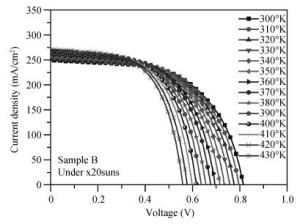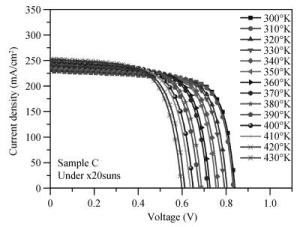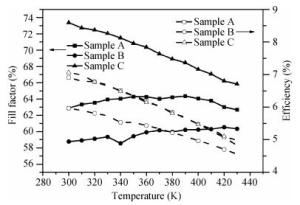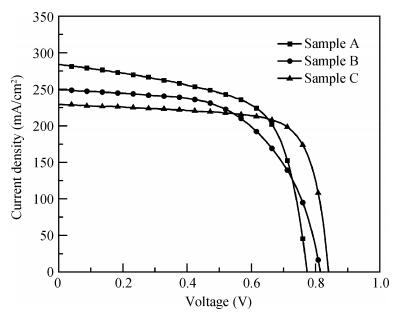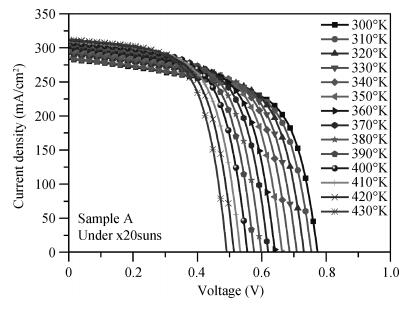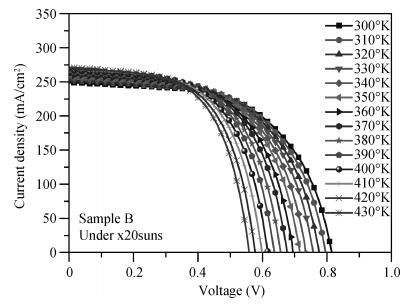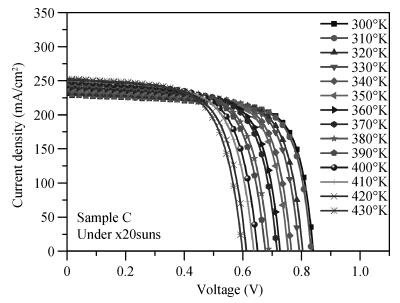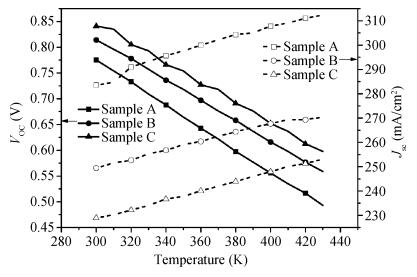| Citation: |
E. Garduno-Nolasco, M. Missous, D. Donoval, J. Kovac, M. Mikolasek. Temperature dependence of InAs/GaAs quantum dots solar photovoltaic devices[J]. Journal of Semiconductors, 2014, 35(5): 054001. doi: 10.1088/1674-4926/35/5/054001
E. Garduno-Nolasco, M. Missous, D. Donoval, J. Kovac, M. Mikolasek. Temperature dependence of InAs/GaAs quantum dots solar photovoltaic devices[J]. J. Semicond., 2014, 35(5): 054001. doi: 10.1088/1674-4926/35/5/054001.
Export: BibTex EndNote
|
Temperature dependence of InAs/GaAs quantum dots solar photovoltaic devices
doi: 10.1088/1674-4926/35/5/054001
More Information-
Abstract
This paper presents the temperature dependence measurements characterisation of several InAs/GaAs quantum dots (QDs) solar cell devices. The devices with cylindrical geometry were fabricated and characterised on-wafer under 20 suns in a temperature range from 300°K to 430°K. The temperature dependence parameters such as open circuit voltage, short circuit density current, fill factor and efficiency are studied in detail. The increase of temperature produces an enhancement of the short circuit current. However, the open circuit voltage is degraded because the temperature increases the recombination phenomena involved, as well as reducing the effective band gap of the semiconductor. -
References
[1] Fan J C C. Theoretical temperature dependence of solar cell parameters. Solar Cells, 17(2/3): 309[2] Philipps S P, Stetter D, Hoheisel R, et al. Characterization and numerical modeling of the temperature-dependent behavior of GaAs solar cells. 23rd European Photovoltaic Solar Energy Conference, 2008:114[3] Konovalov I, Strikha V, Breitenstein O. Activation energy of local currents in solar cells measured by thermal methods. Progress in Photovoltaics:Research and Applications, 1998, 6(3):151 doi: 10.1002/(ISSN)1099-159X[4] Tsuno Y, Hishikawa Y, Kurokawa K. Temperature and irradiance dependence of the I-V curves of various kinds of solar cells. 15th International Photovoltaic Science & Engineering Conference (PVSEC-15), 2005[5] Li J V, Johnston S W, Yan Y, et al. Measuring temperature-dependent activation energy in thermally activated processes:A 2D Arrhenius plot method. Rev Sci Instrum, 2010, 81(3):033910 doi: 10.1063/1.3361130[6] Coello J, Castro M, Antón I, et al. Conversion of commercial Si solar cells to keep their efficient performance at 15 suns. Progress in Photovoltaics:Research and Applications, 2004, 12(5):323 doi: 10.1002/(ISSN)1099-159X[7] Liang J, Schiff E A, Guha S, et al. Temperature-dependent open-circuit voltage measurements and light-soaking in hydrogenated amorphous silcon solar cells. Materials Research Society Symposium, 2005:862[8] Riedel I, Parisi J, Dyakonov V, et al. Effect of temperature and illumination on the electrical characteristics of polymer-fullerene bulk-heterojunction solar cells. Adv Funct Mater, 2004, 14(1):38 doi: 10.1002/(ISSN)1616-3028[9] Carlson D E, Lin G, Ganguly G. Temperature dependence of amorphous silicon solar cell PV parameters. Conference Record of the Twenty-Eighth IEEE Photovoltaic Specialists Conference, 2000:707[10] Luque A, Martí A, Stanley C. Understanding intermediate-band solar cells. Nature Photonics, 2012, 6:146 doi: 10.1038/nphoton.2012.1[11] Meneses-Rodriguez D, Horley P P, Gonzalez-Hernandez J, et al. Photovoltaic solar cells performance at elevated temperatures. Solar Energy, 2005, 78(2):243 doi: 10.1016/j.solener.2004.05.016[12] Sablon K A, Little J W, Mitin V, et al. High-efficiency quantum dot solar cells due to inter-dot n-doping. Proc SPIE 8111, Next Generation (Nano) Photonic and Cell Technologies for Solar Energy Conversion Ⅱ, 2011[13] Garcia-Belmonte G. Temperature dependence of open-circuit voltage in organic solar cells from generation——recombination kinetic balance. Solar Energy Materials & Solar Cells, 2010, 94:2166[14] Katz E A, Faiman D, Tuladhar S M, et al. Temperature dependence for the photovoltaic device parameters of polymer-fullerene solar cells under operating conditions. J Appl Phys, 2001, 90(10):5343 doi: 10.1063/1.1412270[15] Hamadeh H. Temperature dependence of pin solar cell parameters with intrinsic layers made of pm-Si:H and low crystalline volume fraction mc-Si:H. Renewable Energy, 2010, 34:1419[16] Zdeněk M, Vítězslav B, Radim B. Parameters of photovoltaic cells in dependence on irradiance and temperature. Electroscope, 2007:11 -
Proportional views





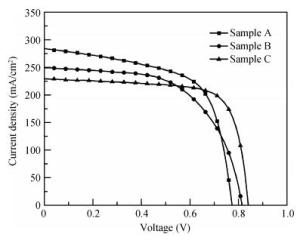
 DownLoad:
DownLoad:

